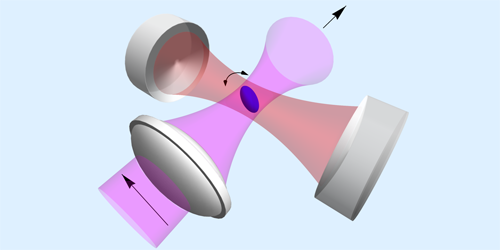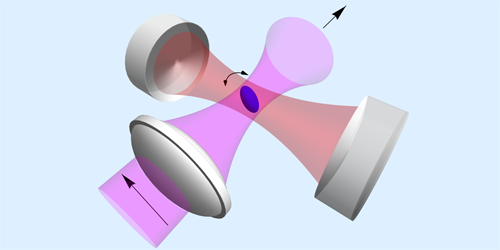Twisting in Thin Air
Levitated nanoparticles can be used in ultrasensitive force measurements and fundamental tests of quantum physics. Unlike prior efforts that have focused on the translational vibrations of these nanoparticles, a new study considers the torsional motion. The researchers used polarized laser light to measure, for the first time, the twisting oscillations of oblong-shaped nanoparticles trapped in an optical field. The results suggest that this torsional motion can be cooled to zero oscillations (on average), corresponding to the torsional ground state.
For levitation experiments, focused laser beams create a trap that confines the translational motion of nanoparticles to back-and-forth oscillations at a specific frequency. Laser cooling can reduce these oscillations, but current techniques cannot reach the ground state. One solution is higher oscillation frequencies. In this case, the energy left after cooling is less than one quantum of oscillation, so the nanoparticle ends up in its ground state. However, making a higher-frequency optical trap would require higher laser power, which has the negative effect of heating the nanoparticles.
An alternative path is the use of a different oscillation mode. Tongcang Li of Purdue University, Indiana, and collaborators investigated the torsional motions of nanoparticles levitated with a linearly polarized laser. The oblong-shaped nanoparticles within the sample aligned themselves lengthwise along the laser’s polarization axis. The researchers showed that these ellipsoids twist back and forth around this axis with a frequency of 1 MHz, a factor of 6 higher than that of the particles’ translational vibrations. The team outlined a possible cooling method that could place nanoparticles in their torsional ground state. They also imagined the system as an ultrasensitive detector that could measure torques on single particles.
This research is published in Physical Review Letters.
–Michael Schirber
Michael Schirber is a Corresponding Editor for Physics based in Lyon, France.
Correction (19 September 2016): The article was corrected to state that the torsional oscillations occurred in an optical field, distinguishing it from earlier work that explored rotational motion of aspherical nanoparticles.





